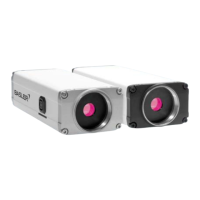AW00097209000 Configuring the Camera
Basler IP Fixed Box Cameras 7
3 Configuring the Camera
This section describes how to configure your camera. It is intended to be used by administrators
who have full access rights to the camera.
3.1 Introduction
When adjusting the parameters used to configure the camera, it helps to have an overview of the
camera’s functionality in mind. Figure 2 on page 9 shows a block diagram of the camera outlining
the basic functional units in the camera and shows how they are related.
As shown in Figure 2, the camera includes a sensor that captures images. The images are passed
from the sensor to a microprocessor. In the microprocessor, a variety of tasks are performed on the
captured images, such as white balancing and motion detection. Note that there is a path from the
microprocessor to the imaging sensor. This path allows the processor to control how the sensor will
capture images (e.g., the size of the image area captured and the image capture rate).
Once images are captured and processed, they are passed to three separate video encoders in the
camera. These encoders are designated as the stream 0 encoder, the stream 1 encoder, and the
stream 2 encoder. Each encoder can be configured separately. The stream 0 encoder is always
enabled and can be configured to use MJPEG, MPEG4, H.264 Base Profile, H.264 High Profile, or
JPEG (triggered) video encoding. The stream 1 and stream 2 encoders can be enabled or disabled
by the user, and can also be configured to use MJPEG, MPEG4, H.264 Base Profile, H.264 High
Profile or JPEG (triggered) video encoding.
Each encoder feeds a live buffer and an alarm buffer. As shown in the drawing, multiple network
devices (usually computers) can access each encoder stream. A device can access the live buffer
for a stream, the alarm buffer for a stream, or both. A device can also open multiple connections to
the camera’s streams (each connection is commonly referred to as a "network stream").
In essence, the camera can produce up to three differently configured video streams and each
stream can be accessed by multiple network users.
Normal Operating Mode and Configuration Mode
As shown in Figure 2, there are groups of parameters that affect the functionality of the camera at
various stages of its operation. You configure the camera by setting these parameters.
When the camera is in its "normal" operating mode, it captures images, processes them, encodes
them, and streams them to external devices via the network connection. In normal mode, most of
the camera’s parameters can be changed, and a change to a parameter will have an immediate
effect on the operation of the camera. If you take a look at the screenshot of the Basler Surveillance
Web Client on page 11, you will see a list of parameter groups on the left side, such as Image

